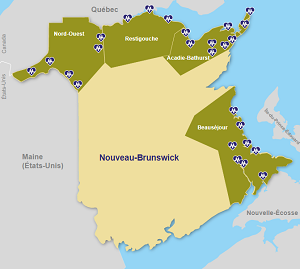Highlights of the Board of Directors public meeting
Moncton, October 6, 2015 – The Board of Directors of Vitalité Health Network held its regular public meeting on Tuesday, October 6, 2015 in Moncton.
Paul Couturier, Chairman of the Board of Directors, extended a special welcome to Gilles Lanteigne who was attending his first meeting since he had started as President and Chief Executive Officer of the Network last August. “We are pleased to officially welcome you to Vitalité Health Network’s family,” he said.
Network performance
Quality of care and client satisfaction
Canadian Patient Safety Week will take place from October 26 to October 30, 2015 and the Network is planning on participating actively. Activities will be held for the public and employees in the main hospital facilities under the slogan, “Keep an eye out for safety!” The purpose of the week is to make health professionals and the public aware of the challenges related to patient safety and to promote improvement in safety and quality of care.
The Network was accredited by Accreditation Canada in May 2013. Work has been ongoing since to ensure the necessary follow-ups to maintain this accreditation status. At the same time the Network is preparing for the next accreditation survey, scheduled for May 2017, during which we will be aiming for accreditation with exemplary standing. This fall work teams will be set up, results will be analyzed, and an action plan will be developed. The Board of Directors’ Quality and Risk Management Committee is coordinating the whole process.
Financial elements
As at August 31, 2015 the Network recorded total expenditures (excluding Medicare) of $237 million compared to the planned budget of $238.2 million, i.e. a surplus of $1.2 million. The Network recorded a surplus of $1.4 million in employee salaries and benefits. Operating expenditures (excluding salaries and benefits) were noted to be higher than the planned budget, with a shortfall of $128,163. Several areas are in deficit, including medication expenditures, equipment maintenance, laboratory supplies, and food supplies.
New Smoke-Free Environment policy
The Board of Directors approved the Smoke-Free Environment policy. This policy, which will become effective on January 1, 2016, stipulates that smoking or vaping will be forbidden on any property and in any facilities owned or operated by the Network, including any vehicle parked on the Network property. The policy also prohibits employees from smoking or vaping in their work vehicle and in the patients’ home. This new regional policy will standardize smoking regulations throughout the Network territory. It is also part of the Network’s public health efforts to decrease the smoking rate in New Brunswick, which is 21.8% compared to the Canadian average of 19.3%.
The Smoke-Free Environment policy applies to patients, visitors, the medical staff, all staff members, anyone working on the Network property, as well as to students and volunteers.
“The implementation of this policy is an important part of initiatives to promote the health and wellness of our patients and staff. Given that there is no safe rate of exposure to cigarette smoke, the Smoke-Free Environment strategy supports the concept of a healthy environment for all, including patients, staff members, and visitors,” stated President and Chief Executive Officer Gilles Lanteigne.
Support provided to patients will be an important part of the Network’s approach. “Support through counselling, coaching and/or nicotine replacement therapies will be accessible to all patients admitted to the hospital or to the Extra-Mural Program. Support will also be offered to staff members through a smoking cessation program that will be implemented to help our employees overcome their nicotine addiction or at least manage it when they are on Network property,” concluded Mr. Lanteigne.
Braiding First Nations’ Culture
The Network presented a positive report on a project to build ties with First Nations’ communities and enhance health employees’ cultural competencies. The initiative, called “Braiding First Nations’ Culture,” made it possible to open a constructive dialogue between the Network and the First Nations and allowed almost 200 employees to acquire cultural know-how through training sessions developed in collaboration with all partners. The Network intends on continuing along these lines by keeping on providing cultural training to employees, promoting health care services meeting the cultural needs of First Nations’ communities, and setting up a standing committee to provide liaison between the communities and the various Network facilities and departments.

